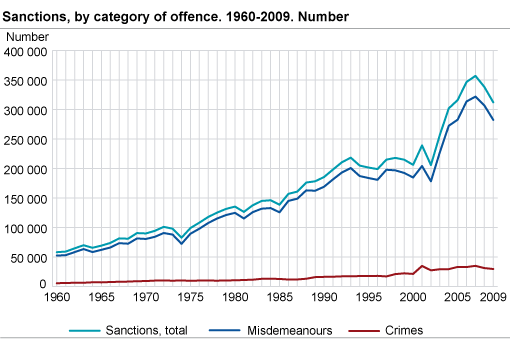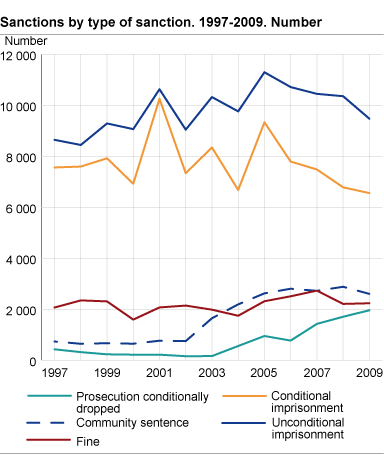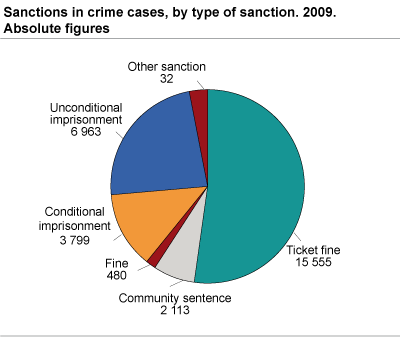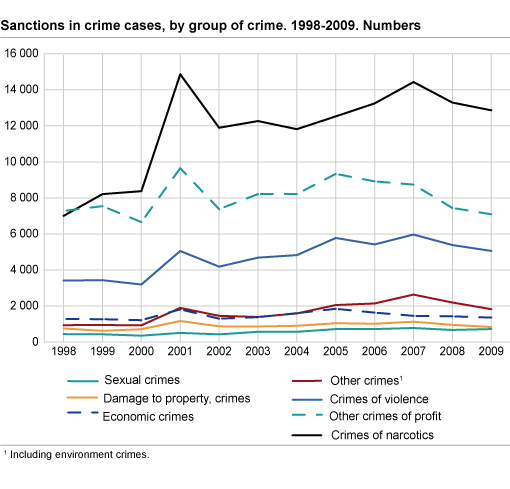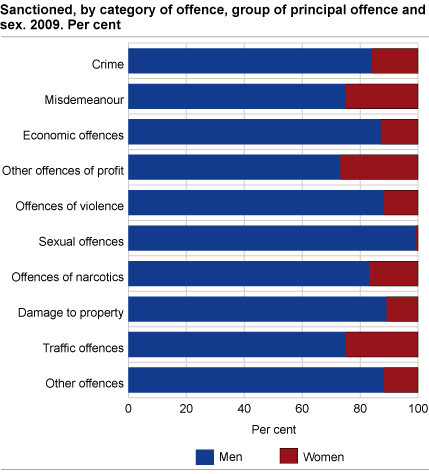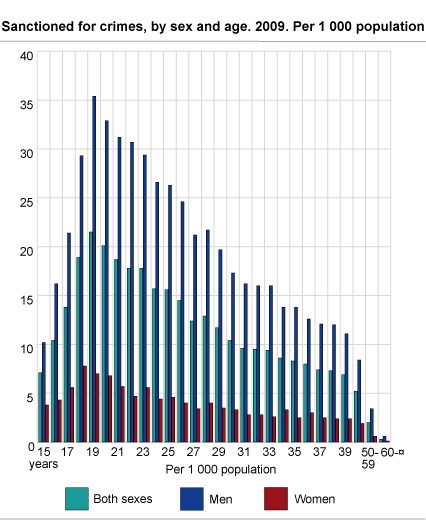Content
Published:
This is an archived release.
Lowest number since 2004
In 2009, 273 500 persons were registered sanctioned, corresponding to 6.9 per cent of the criminal population 15 years and over. The total number of sanctions was 312 300, of which 90 per cent for misdemeanours. A total of 8 per cent fewer sanctions were registered in 2009 compared with the year before.
There was a decline in all major types of punishment, where on the spot fines had clearly the greatest drop in numbers with 22 300 fewer. Ticket fines and on the spot fines combined made up 96 per cent of the total decline in the number of sanctions. Among the more radical sanctions, the largest reductions were in community sentences and unconditional imprisonment sentences; 10 and 9 per cent respectively. In total, the courts imposed 20 900 sanctions; 1 350 fewer than in 2008.
In addition to the 234 000 on the spot fines for traffic misdemeanours and misdemeanours against the Duty Act, prosecutors also imposed 57 400 ticket fines or waivers of prosecution for other offences. Only 44 sanctions were finally decided in the Supreme Court, 1 100 in the lower courts of appeal and 19 800 were completed in city and district courts.
Half of the crime cases settled out of court
Fifty-two per cent of sanctions for crimes were settled by ticket fines. Twenty-three per cent of crime cases resulted in unconditional imprisonment, 13 per cent conditional imprisonment and 7 per cent community sentence. The Court rarely imposes fines without any additional sanction, and only 2 per cent of all crime cases ended with this type of punishment in 2009.
Largest decrease in narcotics crimes
Five per cent fewer sanctions were recorded for crimes in 2009 compared to the previous year. With the exception of sexual offences there was a decrease for all other crime groups. By number, the reduction was greatest for narcotics crimes (400), and sanctions for violation of the Act relating to medicinal goods etc. accounted for almost this entire decline. Narcotics offences is nevertheless still the largest crime group, and was the principal offence in 43 per cent of all crime cases.
In 2009, 7 100 sanctions had crime of profit as principal offence; 5 per cent fewer than in 2008. The number of aggravated larcenies had a decrease of 12 per cent. However, 8 per cent more sanctions were imposed for simple and minor larcenies, especially theft from a shop - where there was an increase of 300 sanctions.
Larger decline for women
Men are sanctioned far more often than women, and the differences between the sexes are greatest for the more serious offences. Overall, 24 per cent of all sanctioned in 2009 were women, while the corresponding proportion is 16 per cent among those who were sanctioned for at least one crime. Compared with the previous year, 6 per cent fewer women and 3 per cent fewer men were punished for one or more crimes.
Twelve per cent fewer sanctions towards women for narcotics crimes contributed most to the overall proportion of women being less than the year before. The change for men was more spread between different types of offences.
Most sanctioned in their twenties
The decline in the numbers sanctioned is distributed relatively evenly in all age groups, but among those who were sanctioned for crimes the percentage of decline is greatest for those aged 15-17 years and those aged 50-59 years; 8 and 10 per cent respectively. Those aged about 20 years are still clearly most overrepresented, which applies to both women and men. In 2009, 3.3 per cent of all resident men and 0.7 per cent of all resident women aged 18-20 years were sanctioned for one or more crimes.
Largest share of sanctioned in Aust- and Vest-Agder
Persons living in Aust-Agder have most sanctions, with 96.6 sanctioned per 1 000 population, in comparison to 66.4 per 1 000 population in the whole country. However persons living in Vest-Agder had most sanctions for crimes, and 8.5 per 1 000 population were sanctioned for at least one crime. Of all residents in Norway who were sanctioned for crimes, 15 per cent (3 400 out of 23 300), however, were residents in Oslo. Oppland had the smallest share of persons sanctioned for crimes, with less than half the share in Vest-Agder. When including all misdemeanours, Troms is the county with the smallest share of persons sanctioned, with 43.4 per 1 000 population sanctioned in 2009.
Tables
Contact
-
Sigmund Book Mohn
E-mail: sigmund.mohn@ssb.no
tel.: (+47) 94 32 77 22
-
Reid Jone Stene
E-mail: reid.jone.stene@ssb.no
tel.: (+47) 99 02 22 01

